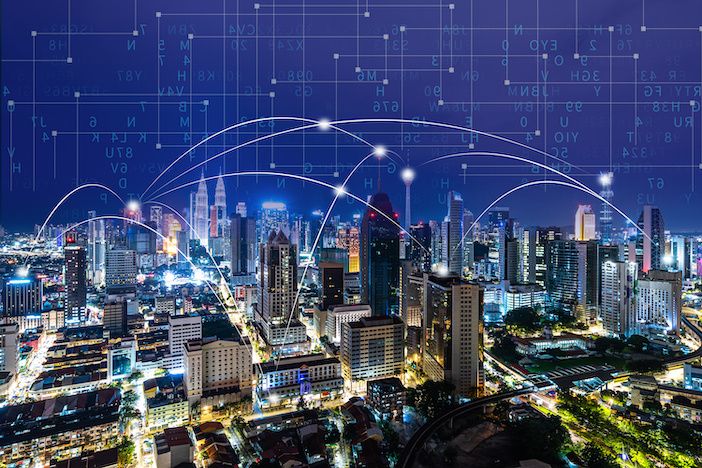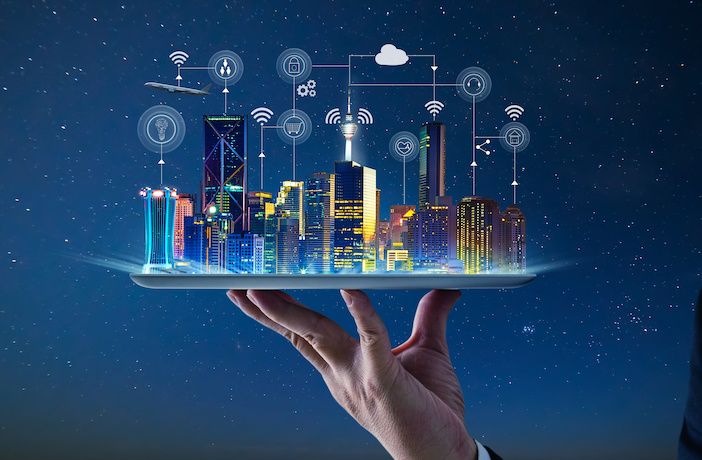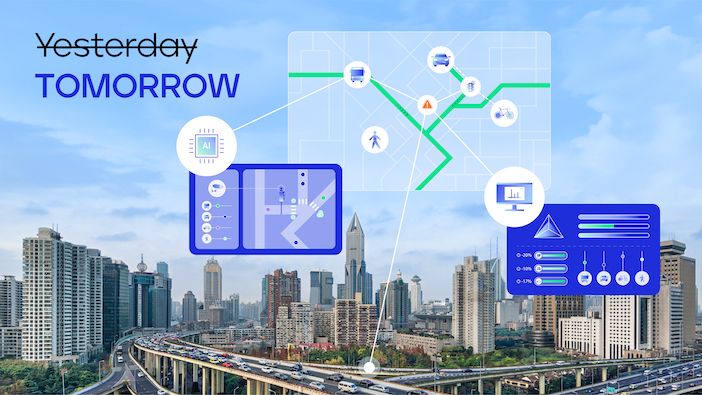In this article experts from Yunex Traffic explore how the next generation of traffic management will help cities embrace a cleaner, brighter future. You can find out more at Yunex Traffic’s stand 01.327 at Intertraffic Amsterdam, April 16-19, 2024.
In the face of the climate crisis, urbanization, and digitalization, global trends mandate a critical reevaluation of various aspects of life – with the transport sector emerging as a primary focal point. Globally, around 20% of CO2 emissions can be attributed to mobility, rising to around 30% in Europe. In our cities, the prevalence of traffic congestion and air pollution hardly surprises. Shockingly, 99% of the global population breathes air that exceeds WHO air quality limits.
The challenges that lie ahead cannot be effectively addressed using the current paradigms of traffic management. Instead, a shift towards more intelligent, data driven responses tailored to specific challenges is needed.
The intricate relationship between climate factors, urbanization dynamics, and technological advancements demands a comprehensive understanding of the entire transportation ecosystem. Isolated traffic management solutions are no longer feasible, considering the complex connections between mobility, climate, city life, and technology.
Dynamic traffic management for an ever-changing world
Cities around the globe have already started to utilize modular extensions of their traffic management systems to optimize their traffic based on variable control capabilities. The German city Wiesbaden, for example, relies on the Environmental Traffic Management (ETM) provided by Yunex Traffic. This system integrates air quality measurements and the detection of pollutants such as NO2 and PM, weather, and traffic data to recognize and forecast traffic patterns. Operators then use this forecast and powerful simulation tools to evaluate traffic strategies and proactively prevent congestion and pollution hotspots. Road users receive recommendations on speed and road use via dynamic traffic signs. The result: less congestion, smoother traffic and: fewer emissions.

This example highlights an important trend that can be recognized worldwide: While cities used to buy standalone traffic management systems and use them for the next 10-15 years, today’s paradigm has shifted towards a platform-based approach.
When tackling the many challenges of traffic management, ranging from reducing emissions to getting infrastructure ready for autonomous driving, traffic managers used to resort to individual traffic management solutions. This fragmented approach does not only cost a lot of valuable time. It also neglects untapped potential.
From individual solutions to comprehensive platforms
Cloud based traffic management platforms are always up to date and can be dynamically expanded with new capabilities and management features – just as the dynamic changes in our world demand. By connecting traffic management data points in a single platform, traffic managers and decision makers can quickly respond to situations and manage the traffic based on customized needs. Less emissions, less congestion and more reliable mobility options will improve the commute experience for citizens and ultimately increase the quality of life in metropolitan areas.

The encouraging news is that holistic, adaptable traffic management platforms are already in place turning the vision of safe, sustainable, and affordable mobility into a tangible reality. With its comprehensive traffic management platform Yutraffic Symphony, Yunex Traffic is driving the technological innovation in the ITS industry. The platform enables cities of all sizes to solve their individual traffic challenges in one place – from urban traffic control to multimodal traffic management. Yutraffic Symphony supports operators to make better and more sustainable decisions, from simple tasks such as monitoring and maintaining field devices to complex solutions such as traffic management involving environmental data, simulations, or even connected vehicles.
Data-driven business models will disrupt the ITS industry of tomorrow
The Intelligent Transportation Systems (ITS) industry is currently undergoing unprecedented disruption. By analyzing massive real-time data sets and connecting IoT devices with comprehensive traffic management platforms, the ITS sector will increasingly offer tailored predictive analytics services, and a shift towards subscription-based business models can be expected.

The power of data will provide additional monetization opportunities, for example, by offering valuable insights from IoT-generated data to third parties. Faster digital connections, powered by 5G and the IoT, will unleash the full power of this new data economy era. In the next 5 years, more developments and milestones in transportation technology can be expected than in the last 100 years combined.
As mobility becomes increasingly prevalent, data-based, intelligent solutions will play a crucial role in minimizing the risk of accidents and enhancing the safety of the most vulnerable road users.
Artificial Intelligence is here to stay
One example is Yunex Traffic’s AI-driven detection system Yutraffic awareAI, which anonymously analyzes the movements of all road users in the live image of intersections. By using AI to detect, classify, and track everyone involved, green lights at intersections can be extended for larger groups of pedestrians, wheelchair users or elderly people. Additionally, this system alerts motorized vehicles about vulnerable road users to increase safety. The insights allow traffic operators to adjust their strategies and improve existing traffic management systems. Furthermore, solutions like this can support autonomous driving vehicles by gathering environmental data from the road infrastructure perspective, providing an extra layer of safety and predictability.

The role of AI will extend from the simulation of scenarios to the prediction of traffic trends. These predictions can be integrated into adaptive traffic control applications such as Yutraffic Fusion. This system uses data from multiple sources and with this, new advanced decision-making approaches control and optimize road networks and transport infrastructure for all road users. The system is adaptable and suitable for applications of any size and enables cities to manage their complex road networks and to optimize traffic flow, supported by AI.
As digital and physical infrastructure increasingly converge, cybersecurity will be an elementary success factor to ensure the critical infrastructure is secured. Cyberattacks and vulnerabilities in one area can have a cascading effect on numerous other areas. If they’re not already doing so, cities should embed cybersecurity as an integrated approach throughout the smart city development process, from the planning, design, and transformation stages, considering industry standards, legal and regulatory requirements.
Faster than ever: Tomorrow has arrived
Ultimately, the interplay of these advancements will reshape the mobility landscape. Collaborative ecosystems in which disparate businesses share data and insights through interconnected platforms will flourish, fostering new opportunities and disrupt traditional industry boundaries. Within the next few years, this vision will be a forthcoming reality. The future of mobility is not a distant prospect but a practical journey that can be started today. The groundwork has already been laid and is now waiting to be deployed. Faster than ever, more disruptive than ever.





